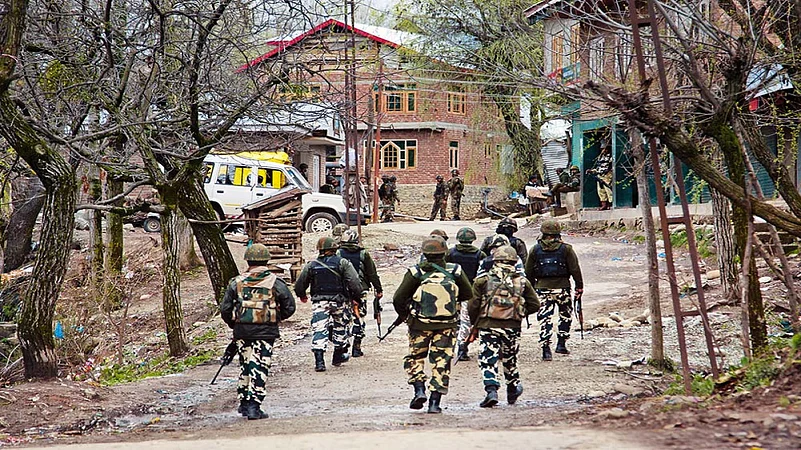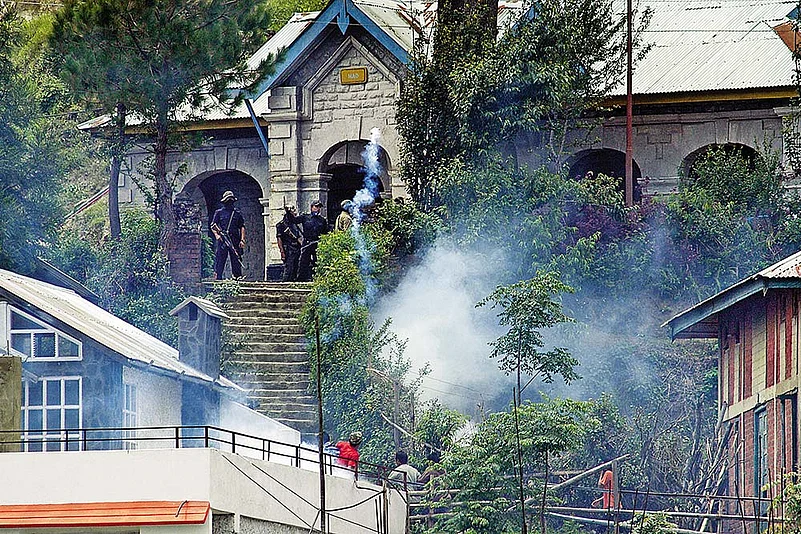On the cold, dark winter evening of Dec-e-mber 4, 2021, the Indian Army’s Spe-c-ial Forces, acting on specific int-elli-gence, laid an ambush for insurgents in Mon district of Nagaland. On that fateful day, six innocent people were killed in the firing on a vehicle suspected of ferrying insurgents. Two other passengers injured in the incident were evacuated to a nearby hospital, by the Army personnel. The incident turned out to be a case of ‘mistaken identity’.
To Be or Not To Be: Clamour For Repeal Of AFSPA Is Ill-informed Of Ground Reality
Contrary to popular perception, the law has necessary checks and balances. And the Army needs it to be effective in conflict zones.

Even as the army authorities were quick to ack-nowledge their grave mistake, an angry mob, armed with dahs (traditional broadsword) ass-aulted the army personnel, killing one soldier and injuring several others. Two army vehicles were burnt. The army personnel opened fire to disperse the hostile crowd, and seven more people lost their lives in the firing.
On the following day, an enraged mob again att-acked the Company Operating Base of Assam Rifles in Mon town, compelling the troops holding the base to open fire to protect lives and pro-perty, resulting in one person being killed and another injured.
On December 6, the Union Home Minister exp-ressed unequivocal regret at the unfortunate turn of events in Parliament. He announ-ced that an inter-agency SIT had been ordered and directed to submit its investigative report within a month.
The Indian Army, on its part, ordered a Court of Inquiry led by a Major General. The probe will investigate: (a) the circumstances under which the incident happened, and pinpoint responsibi-lity; (b) recommend measures to prevent recu-rr-e-nce of such incidents.
Exploiting the rage and anguish among the local people demanding action against the erring Army personnel, are vested interests, raising the ‘revocation of AFSPA’ banner. After any unfortunate incident, AFSPA is used as a trump card to accentuate the sense of alienation, play on turb-ulent sentiments of racial and cultural divide, and even promote secessionism.
‘Why do security forces need AFSPA?’ seems to be the most simple and obvious question following such incidents. A more fundamental question that should be answered first is whether the area is disturbed or not? Once a place has been decla-red “disturbed”, and the government decides to deploy the Army, AFSPA enables the armed for-ces to function effectively in securing stability in the area.
ALSO READ: Poetry | New Terror in Nagaland
The tag of ‘disturbed area’, and consequentially the imposition of AFSPA, is not meant to be a per-manent feature. On multiple occasions across the country, situations of insurgency have been stabilised militarily. This being achieved, it is inc-umbent that political initiatives become predominant, and the condition is conducive for withdrawal of the Act. We have seen such examples of revocation in Punjab, Tripura, Mizoram, Meghalaya and the Imphal Valley.
Unfortunately, more often than not, the political process tends to drag on forever. In Nagaland for instance, a ceasefire came into effect with NSCN (Isak-Muivah) in August 1997. In April 2000, NSCN (Khaplang) also announced a unilateral ceasefire. In the intervening years, both NSCNs—IM and K—underwent multiple splits, with abrogation of ceasefire by some factions opp-osed to peace and stability.
On August 3, 2015, Government of India signed a Framework Agreement with NSCN(IM). On October 31, 2019, another agreement was signed by all NSCN factions under ceasefire, as a step towards a final Naga Peace Accord. Lately, other Naga National Political Groups (NNPGs) and the Gaon Bura Association of Nagaland have started showing political resolve and are being given a stronger voice in the peace process.
Militarily, the situation on ground is still fragile. Even though NSCN cadres live in designated camps, they violate rules of the ceasefire, move around freely with arms and rampantly indulge in extortion, internecine fighting, coercion, and blockades. With little or no reaction against the cadres from the public, it is very difficult for security forces to distinguish between friend and foe.

Mao Gate Bazaar, Nagaland-Manipur border Violent clash between NSCN(IM) rebels and security forces in 2010. (Photograph by Sandipan Chatterjee)
Significantly, China’s handiwork lurks in the shadows since the early sixties, when they trained the Naga, Meitei and Mizo rebel groups. After a slight decline in the nineties, China again revived its contacts by 2011. In July that year, seven Meitei outfits of Manipur, with the support of NSCN(K), established an united front called ‘Coordination Committee’, advocated by China since long. Anthony Shimray, the top NSCN(IM) arms procurer, now in custody, has confirmed that both NSCN(IM) and ULFA (anti--talk faction) have “very close connections” with China. Yunnan in China has become known as the centre for arms procurement.
Under the circumstances, the clamour for revocation of AFSPA is ill-informed of the ground reality. On ground, it is internally fragile with conflicting political agendas, porous borders with Myanmar allowing easy infiltration and exf-iltration of terrorists, smuggling of weapons and drugs, and a persistent threat of China seeking to exploit any adversity.
The armed forces fulfill constitutional responsibilities and act as per the law of the land. There are instances where accountability has been fixed and action taken against individuals for lapses. Punishment awarded to the guilty in the Machhal case in J&K, investigations curre-ntly underway in the Shopian case, are just some examples of action taken.
We must remember that the Army Act and Army Rules are additional stringent laws app-lied to Army personnel, over and above the laws applicable to other citizens of the country.
Often, an argument is made that there are no rules for application of the Act. This too is inco-rrect. In the past, the Supreme Court, while uph-olding the Act, has issued guidelines on its application. Based on these guidelines, standard operating procedures (SOPs) have been put in place to minimise errors in judgement.
The legal protection afforded by the Act is not larger than the principles of human rights. Under the Human Rights Act of 1993, the Army was the first to create a Human Rights Cell in March 1993, even before NHRC was constituted in October of the same year. The role of this Human Rights Cell is to monitor, analyse and respond to alleged human rights violations/excesses by army personnel. Similar cells have also been established at the Comm-a-nd, Corps and Division/Force HQ levels in counter insurgency areas.
Unlike armed forces around the world invol-ved in counter-insurgency/counter-terrorist ope-rations, the Indian Army follows the principle of ‘minimum essential force’. They do not use heavy calibre weapons, artillery, armed/att-ack helicopters, armed UAVs or fighter aircraft. In fact, even cordon-and-search operations that were common in the 1990s, has been done away with, and operations are launched based on specific intelligence. Herein, though, lay a catch. Sometimes, there is a possibility that intellige-nce sources are compromised, misleading security forces into traps.
In the recent instance of December 16, 2021, when the country was celebrating liberation of Bangladesh and India’s spectacular victory over Pakistan, in Kulgam of south Kashmir, our security forces rescued two girls taken hostage by terrorists and eliminated their captors. In such situations, which are common in counter--insurgency/terrorist operations, where insurgents/terrorists seek shelter among the populace, or use civilians as human shields, how can we expect the forces to deliver without the protection of AFSPA?
The Nagaland peace process is in an advanced stage of actualisation. Let the investigation det-e-rmine the guilty and allow the law to take its course. Let us not lower our guard at this critical stage. The disturbed area tag and AFSPA too will go in due course.
(This appeared in the print edition as "To Be or Not To Be")
(Views expressed are personal)
ALSO READ
Lt Gen (retd) Subrata Saha is former Dy Chief of Army Staff and Colonel of the Assam regiment. He has served widely in areas under AFSPA, including J&K, Punjab and the Northeast.

























